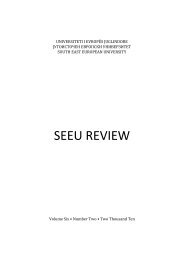SEEU Review vol. 5 Nr. 2 (pdf) - South East European University
SEEU Review vol. 5 Nr. 2 (pdf) - South East European University
SEEU Review vol. 5 Nr. 2 (pdf) - South East European University
Create successful ePaper yourself
Turn your PDF publications into a flip-book with our unique Google optimized e-Paper software.
<strong>SEEU</strong> <strong>Review</strong> Volume 5, No. 2, 2009<br />
Summary<br />
In summary, it can be said that most authors view motivation as central in<br />
education. In addition, teachers play a very important role in student<br />
motivation. Some of the most oft-cited strategies are teachers’ attitudes,<br />
personality, and the relaxing and stress-free atmosphere that the teacher<br />
should create. Moreover, beyond the teacher’s personality and attitudes, the<br />
materials and tasks the teacher uses are important as well as classroom<br />
management. After reviewing the literature about motivation, a list of factors<br />
of motivation was created. (See Appendix A for the list of Factors of<br />
Motivation)<br />
Methodology<br />
Hypothesis and Data Collection<br />
The hypothesis of this research is that: in foreign language classes at<br />
university level where teachers use several identified factors for motivating<br />
students, students will confirm that they are motivated. Such a hypothesis<br />
would be difficult to prove without appropriate methods of data collection.<br />
In order to obtain relevant results about students’ motivation and the<br />
teachers’ role in this motivation, this research focused on the perspectives of<br />
the students, teachers and the researcher, all of whom were participants in<br />
this study. The study used mixed methodologies because both quantitative<br />
and qualitative data were collected and analyzed. The three methods of data<br />
collection were: classroom observation, students’ responses -- both<br />
numerical selections and written comment -- and teacher’s responses -- both<br />
numerical selections and written comments. These methods of data<br />
collection were selected because the researcher could observe what was<br />
happening in the classroom (qualitative) and then collect both comments<br />
(qualitative) and percentages (quantitative) to demonstrate perceptions.<br />
Having all three sides in<strong>vol</strong>ved in the research is important because<br />
discovering what motivates students requires more than observation alone; it<br />
also requires a thorough study of students’ opinions and responses.<br />
The research took place at <strong>South</strong> <strong>East</strong> <strong>European</strong> <strong>University</strong>, in the end of<br />
the summer semester 2008. Requests were made to all teachers of English at<br />
intermediate and upper-intermediate level. Of the teachers who agreed, six<br />
were selected because they fit the times the observers could be present.<br />
145

















